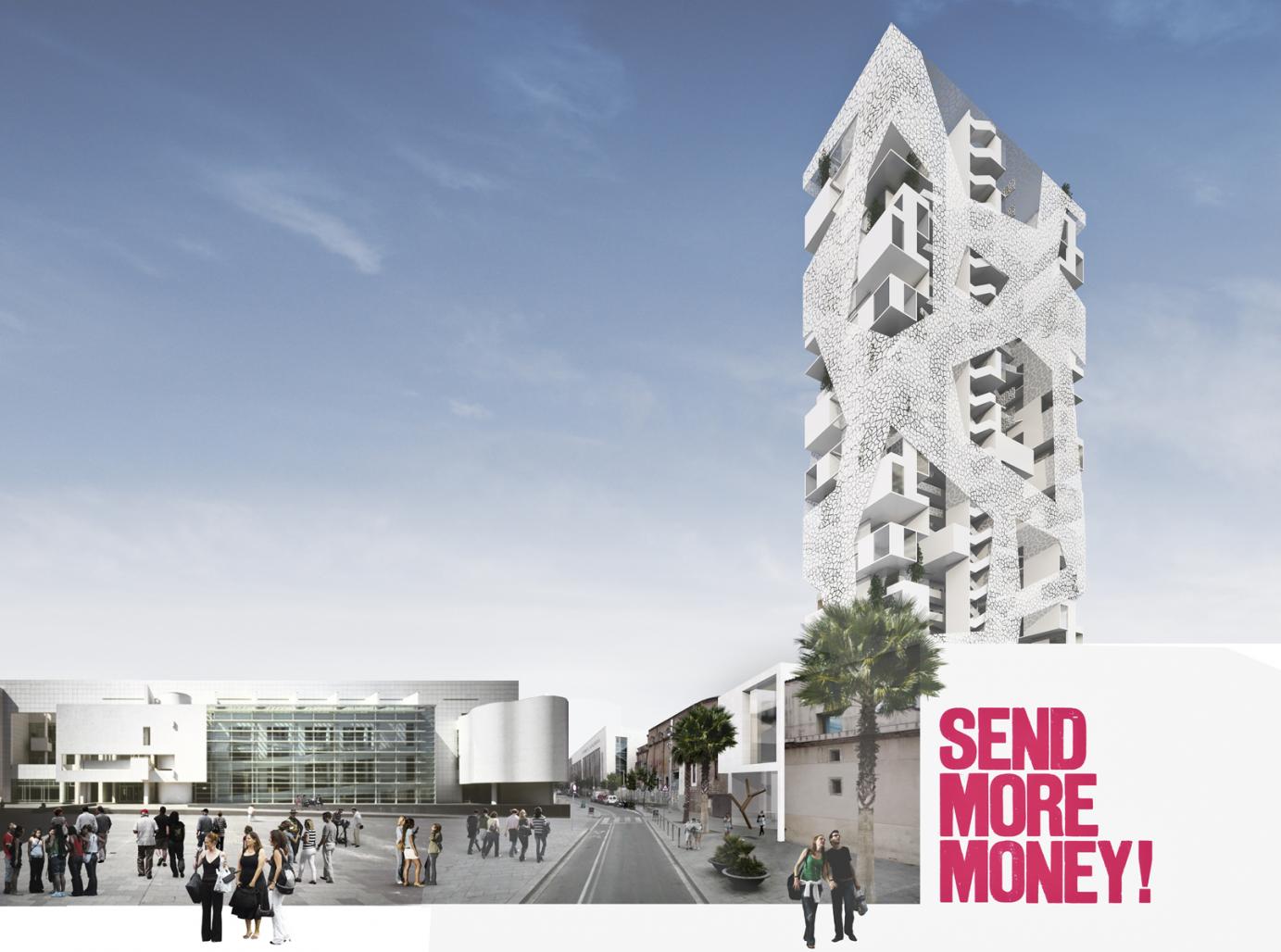Introduction
In an age where speed of information and socio-cultural exchange is followed in an exponential rate, Barcelona takes place between the various world capitals, as one of the privileged centers for the visit of millions of tourists annually.
Privileged culturally and by is geographical location, Barcelona became a meeting center for young visitors, seeking in this city to enjoy a cosmopolitan location, with a characteristic and casual way of life.
It is with this background, that the concept of creating a shelter for these new modern pilgrims of the XXI century is born.
Location
The global vertical village now proposed, is located in the heart of Barcelonas Gothic Quarter and in direct relation to the contemporary museum of Barcelona (MACBA) and its square, assuming itself as a paradigm of globalization, prominent and iconic element of the urban landscape of our cities.
Concept
The functionality and pragmatism of this proposal, intends to address in a simple, linear and concrete way, a program of apparent simplicity, in a building characterized by its formal originality and organization, and of necessarily e consequent easy use and maintenance.
There are two moments in this bohemian hostel”.
A first moment of the building horizontal base, which related in a more directly way with the MACBA square, houses all the public functions of the building, together with the singular mark of the hostel entrance, where all the volumetry is leveled with the average surrounding buildings height and characteristic of the Gothic quarter.
In the second moment, the counterpoint to the horizontal base. The tower.
Element that is wished to be unique, singular and exceptional in the urban landscape of Barcelona, this building is composed by a large vertical element of 100m, that will host the most private areas of the hostel, locating in this volume, rooms, toilets and access.
These two moments are linked by a series of ramps between the different levels, since the MACBA square level, up to the top of the building designated as viewing area.
The inherent verticality in this game of volumes and ramps, in a sensorial connection to the ramp elements used in the MACBA, reinforce the idea of ascension, where the traveler who walks through this space continues his pilgrimage, discovering other cultures and life experiences during is path.
Proposal
The big tower and more private location of this hostel, is organized into five modules of ten double rooms, each linked through a set of ramps, to a column of toilets disposed vertically, one designated to men and other to women.
The vertical toilets concept, which connects each module of ten rooms, aims to allow a bohemian experimental experience of the space, through the enhancement of different views and visual relationships, both inside and outside of the building.
So the result of the game volumes, ramps and empty spaces, it is assumed as a dynamic element of the architectonic ensemble, resulting in an experimental experience at each level of the building, in every yard (“patio”), a characteristic that leads to the imaginary way of life of this city and Mediterranean country.
Program
In the first moment of the building horizontal base, which relates directly to the MACBA square and leads to the independent and controlled hostel entrance, emerges the fashion store, in a direct and special relationship with the plaza and main pedestrian movement.
In this singular hostel entrance marked with a controlled ceiling height, one is invited to enter the interior of the hostel, characterized by a central garden directly related to the same space of the adjacent building, and a empty space visible until the top of the building.
It`s at this street level, which are located the administration, infirmary, storage, general storage and storage maintenance.
At the next level and still at the building horizontal base, is located the dining room with privileged visual view of the MACBA square, kitchen, laundry and general storage facility, in a visual relationship with the entrance lower floor level and upper floors.
The top and last level of the horizontal base also functions as an exterior/interior elevated plaza, where the lounge, terrace, bar and internet terminals areas are located as privileged spaces in their relationship with the surroundings and the rest of the building.
In the second moment, the vertical element that includes the rooms, toilets, access, technical levels and viewing area, emerges as a unique moment of contemplation located at the top of the building, an allegory where the rise culminates in the encounter with the knowledge.
The great volumetric game of rooms, toilets and ramps connecting the various levels, are involved in a modular photo-voltaic skin, based on the icon of the characteristic broken mosaics of Gaudi, providing efficient solar control and heat throughout the year, enhancing the sustainability of the building and visual permeability of their inner light, a play of shadows and dynamic light contrasts.
This skin” reflects the careful and logic concept of the building in terms of sustainability and “zero ecological impact, also demonstrated in the existence of gardens and tree elements located along the strong verticality of the building, allowing to capture water on various platforms and technical floors, to be used later on depending on the needs of this self-sustaining organism.
The sustainability concept is also applied in the hostel elevators, through the coupling of a regeneration technology allowing the reduction by 20% of the regular energy consumption and transforming it into a source of income, since that the energy produced by the elevator can be used to feed the buildings common areas.
2011
Design Team: S3 ARQUITECTOS
Arq. Bernardo Daupiás Alves
country: Portugal
Arqta. Egle Bazaraite
country: Lithuania
Arq. Marco Braizinha
country: Portugal
Favorited 1 times






